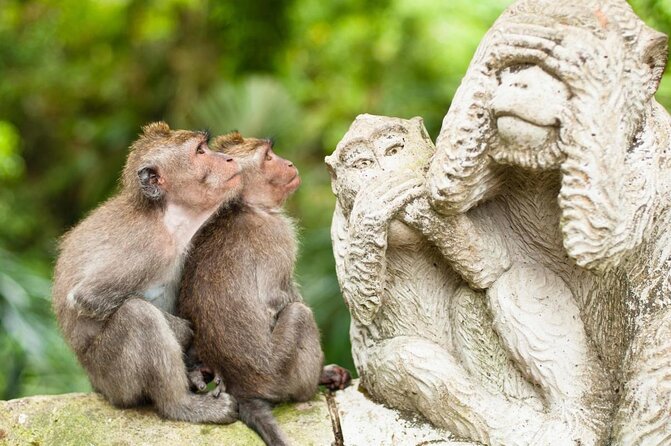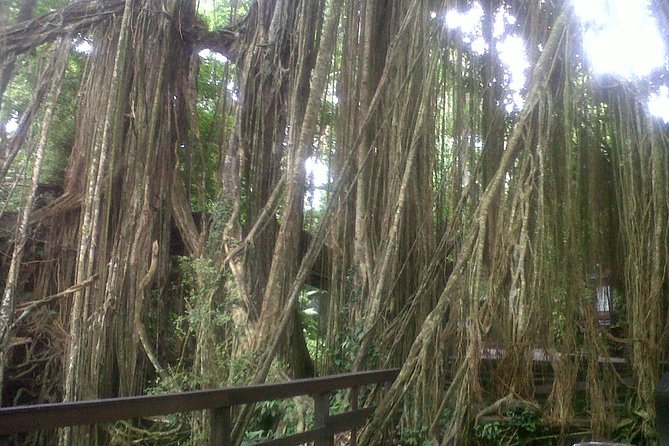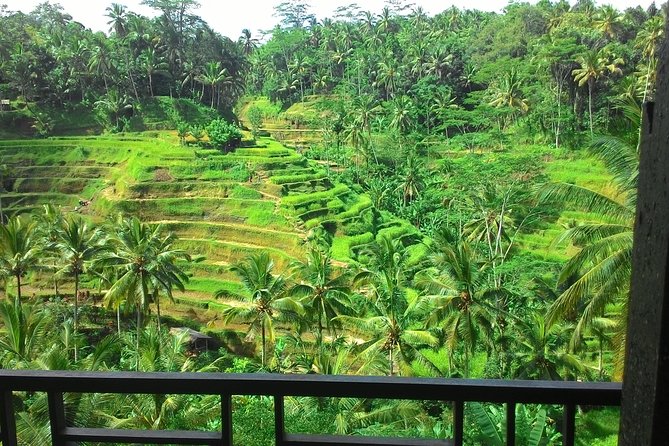Nestled amidst the enchanting landscapes of Bali, Monkey Forest, Ubud, and Rice Terraces beckon curious travelers to explore their hidden wonders. What is it about these captivating destinations that lure visitors from all corners of the globe?
Is it the mischievous antics of the monkeys in their sanctuary, the vibrant art markets of Ubud, or the breathtaking vistas of terraced rice fields?
As the sun begins to set on this tropical paradise, one can’t help but wonder what lies beyond the well-trodden paths of these iconic attractions. Prepare to be captivated, for this journey promises to unveil the secrets of Monkey Forest, Ubud, and Rice Terraces that few have had the pleasure of discovering.
Good To Know

- Monkey Forest Sanctuary in Ubud offers a unique experience with over 700 resident monkeys in a lush and stunning natural habitat.
- The Ubud Art Market is a vibrant and diverse market that showcases traditional crafts and handmade items, offering a great opportunity to bargain for Balinese crafts.
- The Tegalalang Rice Terraces provide a picturesque backdrop for photography and a chance to learn about traditional agricultural practices and farming techniques.
- Goa Gajah (Elephant Cave) and Tirta Empul Temple are fascinating archaeological sites near Ubud that hold historical and spiritual significance, with intricate carvings and a tranquil atmosphere.
Monkey Forest Sanctuary

Located in Ubud, the Monkey Forest Sanctuary is a captivating destination that offers a unique and immersive experience with its resident monkeys. This lush sanctuary is nestled in the heart of Ubud and provides visitors with a chance to observe and interact with over 700 long-tailed macaques in their natural habitat.
As you wander through the dense jungle, you’ll be greeted by mischievous monkeys swinging from trees and playfully scampering along the pathways. The Monkey Forest isn’t only a haven for these playful creatures, but it also boasts stunning natural beauty with towering trees, ancient temples, and serene streams.
To make the most of your visit, it’s recommended to go early in the morning to avoid crowds and witness the monkeys at their most active. It’s important to follow the Monkey Forest etiquette, which includes not feeding the monkeys or making sudden movements that could startle them. This ensures the safety and wellbeing of both visitors and monkeys alike.
Find more activities and experiences we've covered in Bali.
Ubud Art Market

The bustling Ubud Art Market offers a vibrant and immersive shopping experience for visitors seeking unique and authentic Balinese crafts and souvenirs. Located in the heart of Ubud, this market is a haven for art enthusiasts and cultural explorers.
The market is divided into two sections, one for traditional crafts and the other for souvenirs. The traditional crafts section showcases a wide range of handmade items, including intricately carved wooden statues, handwoven textiles, and exquisite silver jewelry. Bargaining is a common practice in the market, and visitors can try their hand at negotiating for the best prices.
Here are a few bargaining tips: start with a lower price, be friendly and polite, and be prepared to walk away if the price doesn’t meet your expectations.
With its bustling atmosphere and diverse selection, the Ubud Art Market is a must-visit destination for those looking to bring home a piece of Balinese culture.
Tegalalang Rice Terraces
After exploring the vibrant and immersive shopping experience at the Ubud Art Market, visitors can venture into the breathtaking beauty of the Tegalalang Rice Terraces. These terraces are a must-visit attraction in Ubud, Bali, known for their stunning landscapes and rich cultural heritage.
The Tegalalang Rice Terraces offer a glimpse into the traditional agricultural practices of the Balinese people, with their intricate system of rice paddies carved into the hillsides. The benefits of visiting these rice terraces are manifold. Not only do they provide a picturesque backdrop for photography enthusiasts, but they also offer an opportunity to learn about the intricate irrigation system and farming techniques used by the locals.
Plus, visitors can enjoy a peaceful and serene ambiance as they take a leisurely stroll through the terraces, seeing the natural beauty of the surroundings.
Campuhan Ridge Walk
Nestled in the heart of Ubud, the Campuhan Ridge Walk offers a captivating hiking experience through lush greenery and breathtaking landscapes. This scenic trail is a favorite among nature enthusiasts and photographers alike.
Here are four reasons why the Campuhan Ridge Walk should be on your itinerary:
Panoramic Views: As you hike along the ridge, you’ll be treated to stunning panoramic views of the surrounding countryside. The rolling hills, terraced rice fields, and distant mountains create a picturesque backdrop that’s truly awe-inspiring.
Serene Atmosphere: Escape the hustle and bustle of the city and learn about the peaceful ambiance of the Campuhan Ridge Walk. The tranquil surroundings and fresh mountain air make it the perfect place to relax and unwind.
Photographic Opportunities: With its natural beauty and breathtaking vistas, the Campuhan Ridge Walk provides endless opportunities for stunning photographs. Whether you’re an amateur or professional photographer, you’ll find plenty of inspiration along the trail.
Cultural Experience: Along the way, you’ll pass by traditional Balinese villages and temples, offering a glimpse into the local way of life. Take the time to interact with the friendly locals and learn about their customs and traditions.
Embark on the Campuhan Ridge Walk and prepare to be mesmerized by its scenic views and peaceful atmosphere. It’s a must-visit destination for nature lovers and adventure seekers alike.
Goa Gajah (Elephant Cave)
Located just a short drive from Ubud, Goa Gajah, also known as the Elephant Cave, is a fascinating archaeological site that offers a glimpse into Bali’s rich cultural heritage.
The Elephant Cave significance lies in its historical and spiritual importance. Dating back to the 11th century, this ancient cave was originally used as a sanctuary for meditation and prayer. As visitors step inside, they’re greeted by a stunning stone entrance carved with intricate figures and mythological creatures.
Exploring further, one can find a small courtyard with ancient bathing pools and a central meditation cave. The walls of the cave are adorned with intricate carvings depicting Hindu deities, animals, and mythological scenes.
The Elephant Cave history is shrouded in mystery, with various theories suggesting that it was once used as a hermitage or as a place for meditation and spiritual rituals.
Today, Goa Gajah continues to be a popular destination for travelers seeking a deeper understanding of Bali’s cultural and religious traditions.
- Bali: Tanah Lot Temple Guided Tour
- Bali: Holiday Return Fast Boat Ticket To / From Nusa Penida
- Bali/Nusa Penida: East & West Highlights Full-Day Tour
- From Bali: 3 Snorkeling Spots Tour to Lembongan and Penida
- Bali: Besakih Temple & Lempuyang Temple Gates of Heaven Tour
- Bali: Mount Batur Sunrise Trek and White Water Rafting
Tirta Empul Temple
Visitors to Ubud can enjoy the rich cultural and spiritual heritage of Bali by exploring the captivating Tirta Empul Temple.
This sacred temple, located in the village of Tampaksiring, is renowned for its Balinese purification ceremonies and spiritual rituals. Here, locals and travelers alike can participate in the age-old tradition of bathing in the holy spring water, which is believed to have healing powers.
The temple’s tranquil atmosphere and beautiful architecture make it a truly enchanting place to visit. As you explore the temple grounds, you’ll learn about the deep-rooted local beliefs and customs that have been passed down through generations.
Tirta Empul Temple offers a unique and immersive experience for those seeking a deeper understanding of Balinese spirituality.
Ubud Palace
What makes Ubud Palace a must-visit attraction in Ubud? The answer lies in its rich history and stunning traditional architecture. Ubud Palace, also known as Puri Saren Agung, is the official residence of the royal family of Ubud. Built in the 1800s, the palace showcases the beauty of Balinese craftsmanship with its intricate carvings and ornate decorations. Visitors can explore the palace grounds, which include beautiful gardens and courtyards. Inside, you’ll find a museum that displays the royal family’s heirlooms and artifacts. Plus, Ubud Palace serves as a venue for traditional Balinese dance performances, providing visitors with a chance to witness the captivating art form. With its cultural significance and architectural splendor, Ubud Palace is a must-see destination for anyone visiting Ubud.
| Feature | Description | Highlight |
|---|---|---|
| History | Built in the 1800s | Showcases Balinese craftsmanship |
| Architecture | Intricate carvings and ornate decorations | Stunning traditional design |
| Palace Grounds | Beautiful gardens and courtyards | Serene atmosphere |
| Museum | Displays the royal family’s heirlooms and artifacts | Insight into Balinese culture |
| Dance Performances | Venue for traditional Balinese dance performances | Captivating art form |
Common Questions
How Much Time Should I Allocate for a Visit to the Monkey Forest Sanctuary?
For a visit to the monkey forest sanctuary, it is recommended to allocate around 1-2 hours. This allows enough time to observe the fascinating monkey behavior and explore the sanctuary at a leisurely pace.
Are There Any Restrictions on Interacting With the Monkeys at the Monkey Forest Sanctuary?
There are safety precautions in place to ensure the well-being of both visitors and monkeys. While there may be restrictions on interacting with the monkeys, these measures aim to protect everyone involved.
Can I Purchase Souvenirs and Local Handicrafts at the Ubud Art Market?
Yes, visitors can purchase souvenirs and local handicrafts at the Ubud Art Market. The market is known for its wide variety of traditional crafts and offers a great opportunity for bargaining with the vendors.
Is It Possible to Hike Through the Tegalalang Rice Terraces?
Yes, it is possible to hike through the Tegalalang rice terraces. The hike offers a scenic beauty and a unique experience of being surrounded by lush green terraces.
What Is the Significance of the Goa Gajah (Elephant Cave) in Ubud?
The Goa Gajah, or Elephant Cave, in Ubud holds historical and religious significance. It is a sacred site that features ancient carvings and a meditation cave, offering visitors a glimpse into the region’s rich cultural heritage.
The Sum Up
To sum it up, a visit to Monkey Forest, Ubud, and Rice Terraces is a must for anyone seeking a unique and enriching experience in Bali.
From interacting with playful monkeys to exploring ancient temples and breathtaking rice terraces, there’s something for all to enjoy.
With the assistance of a knowledgeable driver, you can customize your tour and make the most of your time on this captivating adventure.
Don’t miss out on the opportunity to learn about the natural beauty and cultural heritage of Bali.
More Tour Reviews in Bali
- Bali: Tanah Lot, Jatiluwih Terrace, & Ulundanu Beratan Tour
- Bali: Beaches, Uluwatu Temple Sunset & Fire Kecak Dance Show
- Bali: Ayung River Rafting and Swing Adventure With Lunch
- Ubud: Forest Spa Treatment With Forest Swing
- Bali: Mount Agung Guided Sunrise Hike With Hotel Transfers
- Private Full-Day Tour to the Real Bali Swing and Ubud
Looking for something different? Other Bali activities we've written about
- Best Shopping Tours In Bali
- 4 Best Workshops And Classes In Bali
- 4 Best Spa And Hot Springs Experiences In Bali
- Best Massage And Relaxation Services In Bali
- Best 3 Day Tours In Bali
- 25 Best Tours In Bali
- Best 2 Day Tours In Bali
- 12 Best Private Driver Services In Bali
- 2 Best Boat Tours And Cruises In Bali
- Best Guided Tours In Bali
- 5 Best Photography Experiences In Bali
- 3 Best Airport Transfers In Bali
